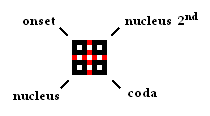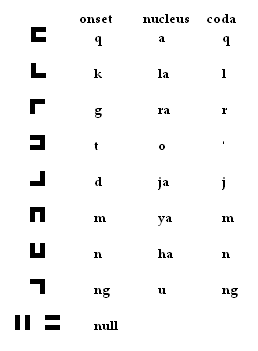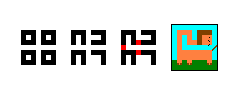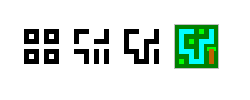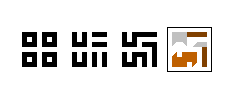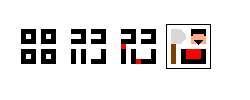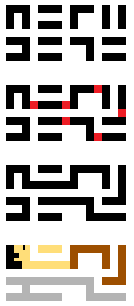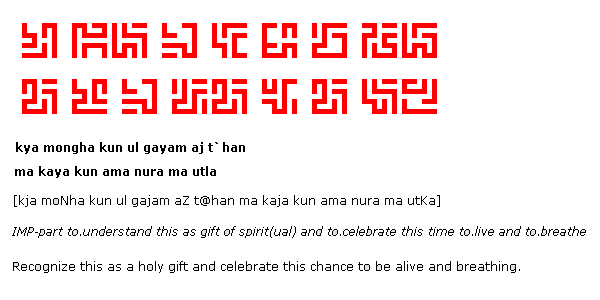Ngala
From FrathWiki
Jump to navigationJump to search
This article is one of many about Qatama
.
Ngala
Ngala is system of quasi-featural glyphs, mostly monosyllabic used to represent the Qatama language. Ngala and the Qatama conlang were invented by Qang for use in his conworld, Qatama. It was created as an alternative to the alphabet Moj.
Notable features
- Ngala can be written vertically, in columns running from left to right, or horizontally.
- The word 'Ngala' not only refers to the script but also means "a square, or a block" in Qatama - referring to the appearance of the glyphs.
- Ngala contains 10 radicals arranged in blocks of four to form mono or disyllabic glyphs.
- Many of the glyphs can be reverse-engineered to resemble the words or ideas they represent.
- There is no punctuation used in Qatama, pauses, stops and questions are understood through the use of context and particles.
Formation of a glyph
Ngala radicals
Guidelines for connecting the radicals
- Each radical should be connected to at least one other radical.
- The radicals should be connected at open points rather than at closed corners.
- Aim to make the glyph be as "pictographic" as possible. Obviously excluding many abstracts and rigidly grammatical lexical entries.
Examples
- myong - n. a large feline, tiger lion…etc. The picture shows a lion looking back over his shoulder.
- As you can see, each radical spot is used, top left: m, bottom left: ya, top right: o, bottom right: ng. In this glyph the o modifies the ya and makes it yo.
- A possible handwritten version of myong, but keep in mind, these glyphs would rarely ever be handwritten.
- guja - n. water, stream, creek The picture shows a stream running throw a forest.
- In the above you see an example of a disyllabic glyph.
- Disyllabic glyphs only occur when the second syllable is one of the following nuclei: a, o, ja, ha, ya, la, ra.
- There are occasions when these are modifying the preceding nucleus and not acting as second syllables and the occurrences are based on phonotactic rules. E.g. ya-a is /ja:.a:/, but ya-o is /jo:/.
- n`ha - n. a cut, gash, slash v. to cut, hack, slice.
- The picture shows an axe and a hatchet cutting a block of wood.
- In this sample you see that only two radical positions are used, this is perfectly acceptable. They are variable to give way to more "pictographic" possibilities.
- toj - n. warrior, fighter, combatant. The picture shows a warrior, his shield and battle axe.
- This sample shows how the secondary nucleus position can be used without the first, the glyph remains readable.
- Another example of a handwritten glyph, toj.
- An example of a dual glyph pictograph.
- mogu /mo:.gu:/ - n. sleep, rest, relaxation | v. to sleep, lay, rest

